Vast and Fast: The Western Digital MyBook Studio II Hard Drive
by Dave Etchells
Posted: 04/02/08
A universal law of storage: "Stuff" always expands to fill the available space
It seems to be a fundamental law that "stuff" (whether it be socks in the sock drawer, coats and random junk in the hall closet or photo files on your hard drive) always expands to fill whatever space is available. Photographers seem particularly prone to this phenomena. While the proverbial shoebox storage for photo prints and negatives was bad enough, the advent of digital cameras catapulted the problem of image storage into another dimension, both figuratively and literally.
Hey, now that we're digital, the photos are free, right? So why not bracket everything you shoot, to make sure you get just the right exposure? Of course, if you really care about your images, you'll shoot RAW, to capture the maximum information for later tweaking. But JPEGs are awfully handy for a quick print or screensaver, so you'll probably want to shoot both RAW and JPEG. And of course, now that we can see what we're getting after each shot, you'll want to experiment with different angles, focal lengths, shutter speeds, flash settings, etc, etc. The good news is that you're getting far more "keepers" than you ever did in the film era (if you're old enough to remember that distant time), but if you're like me, the ratio of total shots to keepers is only somewhat improved: There's just a lot more raw material to select from.
So after a photo session, it's not at all unusual these days to come back with several hundred shots, with maybe a dozen solid keepers buried in their midst. If you're like me though, you're probably loathe to throw any shots away: Chances are, the moment you decide to throw a real stinker in the electronic dust-bin, you'll realize that it was the only frame that showed Aunt Mabel in her Easter bonnet. Or the neighbor's kid in a great action pose on the soccer field. Or something. So you don't throw anything away, and the image files accumulate like breeding bunnies, filling every nook and cranny of available disk space.
Then, for the digicam owner, there's those video files from your camera's movie mode. Yeesh, and you thought the still images were bad! It takes depressingly few minutes of video to burn through a gigabyte of storage.
And let's not even talk about backup! Of course you need to keep at least two copies of everything, as a hedge against the eventual, inevitable death of your hard drive. Plus backup copies of all your work documents, the home budget, Junior's world history report, etc, etc.
So it's probably no surprise to find the typical photographer with their images strewn across a gaggle of miscellaneous hard drives, some here, some there, some backed up three times, others not at all. And at least once a year, we find ourselves scanning the Sunday newspaper ads, looking for the latest hot deal on yet another hard drive.
What to do? Well, we'll all probably continue buying hard drives a regular intervals, but recent drive technology is at least letting the intervals get a little longer. Technology can also help with the backup issue too, in the form of RAID arrays, which store your data redundantly on multiple hard drives.
The Western Digital MyBook Studio II
The latest answer to the drive-space conundrum comes from Western Digital corporation, in the form of their updated MyBook Studio II drive series. As their name suggests, these drives are designed to sit upright on your desk, table, or shelf, looking like slightly overweight books. The drive has a very solid heft to it, but the plastic shell it's packed in felt a little flimsy to me. An aluminum case would have been nice, but undoubtedly would have driven the cost considerably higher.
Inside, there are two drive mechanisms, which can be arranged in either a RAID 0 (one big storage volume), or RAID 1 (one drive's worth of capacity, but with your data stored redundantly on both physical drives). The drive comes out of the box in RAID 0 mode and formatted as a Macintosh HFS+ volume, but software included on the drive lets you change it to RAID 1, as well as choose between Mac or Windows formats. (The software is also on a CD accompanying the drive, necessary if you want to change it to a Windows format, and have only a Windows computer to work with).
Western Digital's Studio II models boost capacity over the original Studio line, now available in capacities (in RAID 0 mode) of 1 TB or 2 TB. (That's TB for Terabytes, 1,000,000,000,000 bytes of storage.) The new lineup also uses WD's "GreenPower(tm)" drive mechanisms, which consume 33% less power than standard drives, letting the Studio II units run cool and quiet.
Getting Connected: Quad Interface
Hard drive interfaces seem to have proliferated almost as much as the drives themselves over the last few years, to the point that you may find USB (1.1 or 2.0), FireWire 400, FireWire 800, and eSATA on your computer. The good news is that the MyBook Studio II units work with any of the above. They're USB 2.0 units, but USB 2.0 is backward-compatible with USB 1.1 connections. (Although USB 1.1 is so slow by comparison that you really wouldn't want to use it for a drive of this size. In a pinch though, it's nice to know that you could plug the drive into an older machine to retrieve your data.) The MyBook Studio II's FireWire interface is a clever 800/400 hybrid. The connectors on the back of the case are the smallish ones normally used for FireWire 800. The MyBook ships with an adapter cable though, that lets you plug it into a FireWire 400 connection, albeit at the slower FireWire 400 data transfer rates. Finally, there's an eSATA (external SATA) connector, in case you have an eSATA card in your computer.
Formatted for Mac, Adaptable to Windows
I mentioned above that the Studio IIs come formatted for the Mac OS, but it bears calling attention to, so readers won't be surprised when they bring theirs home. As a (primarily) Mac user, this is a welcome change; I'm accustomed to having to reformat every drive I buy to work with my Macs, it's nice for a change to be able to just plug and go. For Windows users, it's no big deal, you just load the provided CD, launch the WD RAID Manager software, select the configuration and formatting you want, and tell it to proceed.
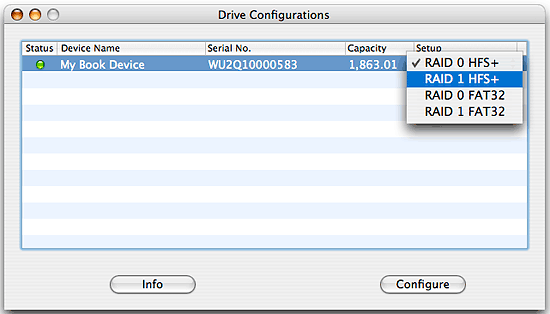
On the Mac, the process is the same if you want to change from a RAID 0 to RAID 1 configuration, as seen in the screen shot above.
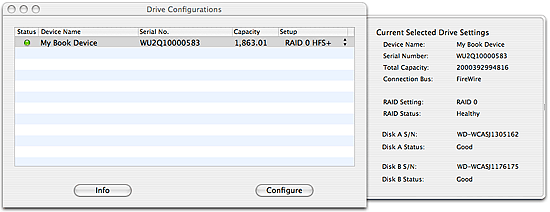
The WD RAID Manager software also lets you check the health of the drive, via the Info button, as seen above.

If you just want a quick check of the drive's health though, the software package installs a little menubar utility called WD Drive Manager that'll show you the basics without having to launch a separate app.
Performance
I don't have a computer with an eSATA interface available to me, so could only test the MyBook Studio II on Macs with FireWire 800. The eSATA interface could be somewhat faster, as it has more available bandwidth than does FireWire 800. Given the transfer rates I measured though, I suspect FireWire 800 was pretty well maxing out the drive. It's also possible that newer Macs than the ones I used could have faster transfer rates over the FireWire bus. All that said though, the transfer rates I measured were really exceptional.
To test the unit (I had the 2 TB version), I connected it to a dual-processor G5 Mac tower (2.3 GHz version), which had some fast SATA drives mounted internally. I also tested it on the G5 XServe (dual 2.0 GHz processors) that we use as our office file server here. The XServe has a 2 TB SATA/SCSI array on it that's blazingly fast, which should avoid any possible limitation on the measured transfer rates due to the host drive's bandwidth.
I tested the unit in both RAID 0 and RAID 1 configurations, and found essentially identical transfer rates in the two modes. - So I'm only showing the RAID 1 figures below. Here's what I found:
| System | Read (MB/sec) |
Write (MB/sec) |
| G5 | 67.59 | 66.67 |
| XServe | 71.10 | 54.05 |
Those are some really fast transfer rates! If all you deal with is spreadsheets and word processing documents, you won't much care about this - But then you probably don't need a drive like the MyBook Studio II either. When you're copying multiple gigabytes of data around though, transfer speeds of 60-70 MB/second are really nice.
Backing up is hard to do (not)
The Western Digital MyBook Studio II drives all ship with a backup application as well, to help you keep your data backed up and current. WD Backup uses a "wizard"-like setup to set up automatic backups, as seen below.
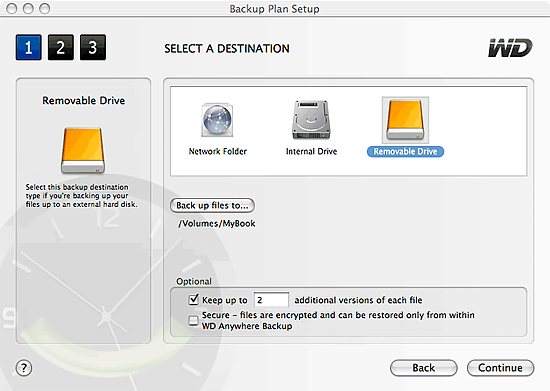
The wizard lets you choose the backup destination (in this case, the MyBook), how many versions of files to keep when it encounters changes, and whether you want the saved data to be encrypted.
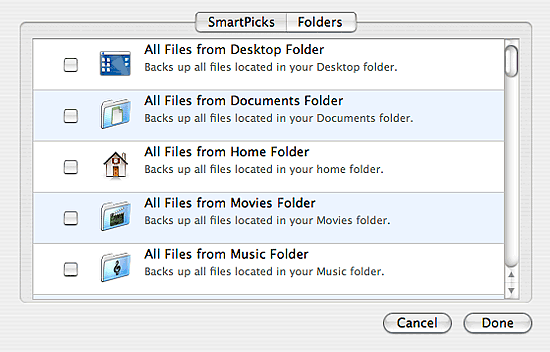
An extensive list of "Smart Picks" can simplify setting up your backup system, letting you choose from more than 30 different types of files just by clicking on check-boxes.
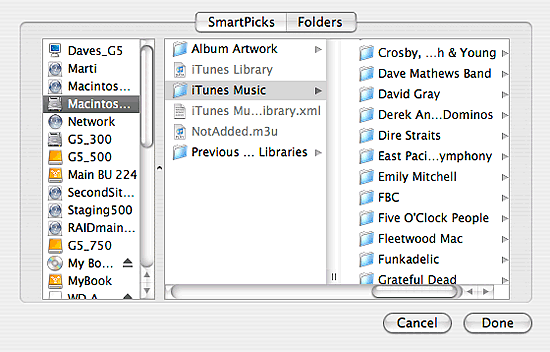
Alternatively, you can simply select folders to be backed up in a normal file dialog.

A summary screen shows you what will be backed up and monitored.
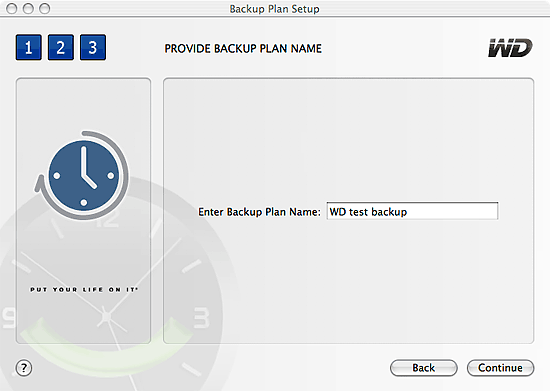
Name the backup set and you're good to go. WD Backup will do an initial backup of the selected data, and then monitor the various folders and file types involved and back them up too, whenever it sees something has changed.
I didn't play a lot with WD Backup, so can't report on how well it worked. It seemed pretty functional, should be a good solution for someone who wants a painless, automatic backup solution.
Cool and Quiet
One thing that really stood out to me in my playing with the MyBook Studio II though, was just how cool and quiet it ran. I mean it was really quiet. If there was no other noise in the room, I could hear it making a faint whir, but if the AC was running, I literally couldn't tell if it was running without checking the pilot light on its front face.
WD touts the GreenPower(tm) drives the MyBook Studio II is built around, as having 33% lower power consumption than competing models. The MyBook is also smart about shutting down the drives when not in use too. Combined with a case with plenty of cooling holes and slots in it, the net result was that the top of the MyBook was barely warm, increasing only slightly in temperature under heavy, continuous use.
RAID 0 or 1? Which for you?
One decision owners of the MyBook will have to make is whether to go for maximum storage space using RAID 0 or increased reliability, using RAID 1. This will be a personal decision for each user, but given the amount of space and the number of files that would represent, I'd personally opt for RAID 1 every time. It's not a 100% guarantee against lost data (the computer's OS could still corrupt the filesystem, or the internal RAID controller could go bad), but it'll still put you way ahead of where you'd be with the RAID 0 setup. (Think about it, with a single volume spanning two physical drives, if either drive goes out, your data is toast. So it's arguably half as reliable as a single drive when running in that mode.)
Of course, if your data primarily resides elsewhere, and you're just using the MyBook as a backup volume, then by all means go for maximum space with RAID 0. (And of course, for the space-hungry but still paranoid, I'm sure Western Digital wouldn't at all mind you buying two MyBooks, running them both in RAID 0 mode, and then using a software RAID solution to copy data redundantly between them. ;-)
Self-Service?
One last thing that impressed me with the MyBook Studio II is that it's designed to permit owner servicing if one of the drives does go bad. You'll need to make sure you get another WD GreenPower(tm) drive as a replacement, but the case is made to open and allow you to swap drives. If you were running in RAID 1 mode, the drive will start rebuilding the redundant data as soon as you power it back up again. Nice.
Conclusion
Especially for Mac-based photographers, the Western Digital MyBook Studio II external hard drive line looks like a winning solution. They offer enormous capacity in a compact physical package, with built-in RAID capability, most any interface option you might wish for, excellent performance, and low power consumption. WD tells us they'll be in the stores starting immediately, priced at US$349.99 and US$599.99 for the 1 and 2 TB versions respectively. Check them out, they could be just the ticket for storing your next year (or three's) photo files!
